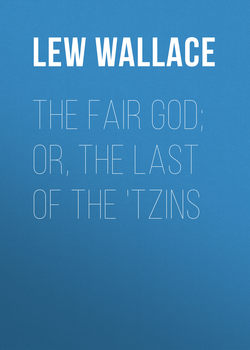Читать книгу The Fair God; or, The Last of the 'Tzins - Lew Wallace, Lewis Wallace - Страница 6
BOOK ONE
CHAPTER IV.
TENOCHTITLAN AT NIGHT
ОглавлениеThe site of the city of Tenochtitlan was chosen by the gods. In the southwestern border of Lake Tezcuco, one morning in 1300, a wandering tribe of Aztecs saw an eagle perched, with outspread wings, upon a cactus, and holding a serpent in its talons. At a word from their priests, they took possession of the marsh, and there stayed their migration and founded the city: such is the tradition. As men love to trace their descent back to some storied greatness, nations delight to associate the gods with their origin.
Originally the Aztecs were barbarous. In their southern march, they brought with them only their arms and a spirit of sovereignty. The valley of Anahuac, when they reached it, was already peopled; in fact, had been so for ages. The cultivation and progress they found and conquered there reacted upon them. They grew apace; and as they carried their shields into neighboring territory, as by intercourse and commerce they crept from out their shell of barbarism, as they strengthened in opulence and dominion, they repudiated the reeds and rushes of which their primal houses were built, and erected enduring temples and residences of Oriental splendor.
Under the smiles of the gods, whom countless victims kept propitiated, the city threw abroad its arms, and, before the passage of a century, became the emporium of the valley. Its people climbed the mountains around, and, in pursuit of captives to grace their festivals, made the conquest of “Mexico.” Then the kings began to centralize. They made Tenochtitlan their capital; under their encouragement, the arts grew and flourished; its market became famous; the nobles and privileged orders made it their dwelling-place; wealth abounded; as a consequence, a vast population speedily filled its walls and extended them as required. At the coming of the “conquistadores,” it contained sixty thousand houses and three hundred thousand souls. Its plat testifies to a high degree of order and regularity, with all the streets running north and south, and intersected by canals, so as to leave quadrilateral blocks. An ancient map, exhibiting the city proper, presents the face of a checker-board, each square, except those of some of the temples and palaces, being meted with mathematical certainty.
Such was the city the ’tzin and the cacique were approaching. Left of them, half a league distant, lay the towers and embattled gate of Xoloc. On the horizon behind paled the fires of Iztapalapan, while those of Tenochtitlan at each moment threw brighter hues into the sky, and more richly empurpled the face of the lake. In mid air, high over all others, like a great torch, blazed the pyre of Huitzil’.12 Out on the sea, the course of the voyageurs was occasionally obstructed by chinampas at anchor, or afloat before the light wind; nearer the walls, the floating gardens multiplied until the passage was as if through an archipelago in miniature. From many of them poured the light of torches; others gave to the grateful sense the melody of flutes and blended voices; while over them the radiance from the temples fell softly, revealing white pavilions, orange-trees, flowering shrubs, and nameless varieties of the unrivalled tropical vegetation. A breeze, strong enough to gently ripple the lake, hovered around the undulating retreats, scattering a largesse of perfume, and so ministering to the voluptuous floramour of the locality.
As the voyageurs proceeded, the city, rising to view, underwent a number of transformations. At first, amidst the light of its own fires,13 it looked like a black sea-shore; directly its towers and turrets became visible, some looming vaguely and dark, others glowing and purpled, the whole magnified by the dim duplication below; then it seemed like a cloud, one half kindled by the sun, the other obscured by the night. As they swept yet nearer, it changed to the likeness of a long, ill-defined wall, over which crept a hum wing-like and strange,—the hum of myriad life.
In silence still they hurried forward. Vessels like their own, but with lanterns of stained aguave at the prows, seeking some favorite chinampa, sped by with benisons from the crews. At length they reached the wall, and, passing through an interval that formed the outlet of a canal, entered the city. Instantly the water became waveless; houses encompassed them; lights gleamed across their way; the hum that hovered over them while out on the lake realized itself in the voices of men and the notes of labor.
Yet farther into the city, the light from the temples increased. From towers, turreted like a Moresco castle, they heard the night-watchers proclaiming the hour. Canoes, in flocks, darted by them, decked with garlands, and laden with the wealth of a merchant, or the trade of a market-man, or full of revellers singing choruses to the stars or to the fair denizens of the palaces. Here and there the canal was bordered with sidewalks of masonry, and sometimes with steps leading from the water up to a portal, about which were companies whose flaunting, parti-colored costumes, brilliant in the mellowed light, had all the appearance of Venetian masqueraders.
At last the canoes gained the great street that continued from the causeway at the south through the whole city; then the Tezcucan touched the ’tzin, and said,—
“The son of ’Hualpilli accepts the challenge, Aztec. In the tianguez to-morrow.”
Without further speech, the foemen leaped on the landing, and separated.
12
The God of War,—aptly called the “Mexican Mars.”
13
There was a fire for each altar in the temples which was inextinguishable; and so numerous were the altars, and so brilliant their fires, that they kept the city illuminated throughout the darkest nights. Prescott, Conq. of Mexico, Vol. I., p 72.
